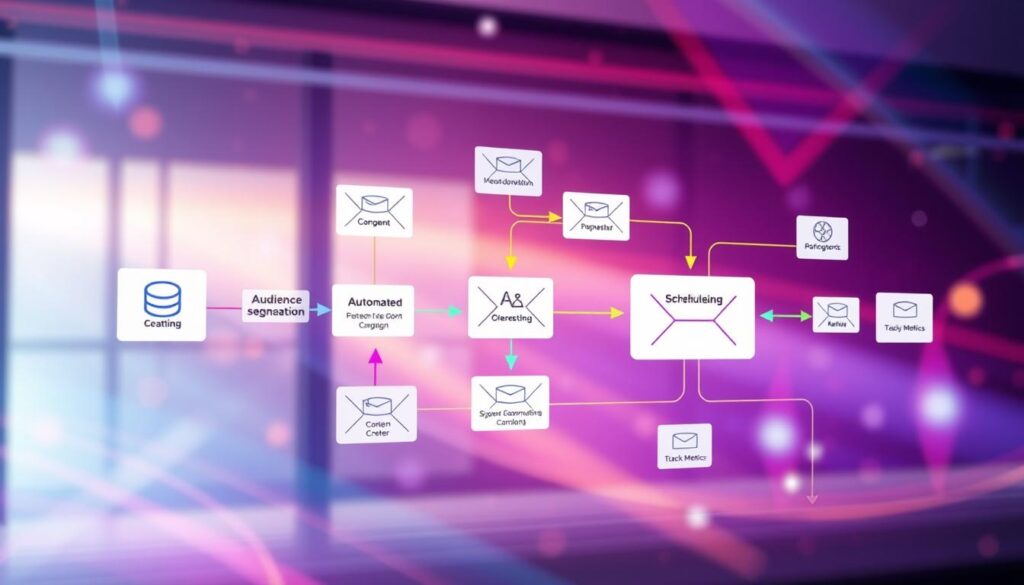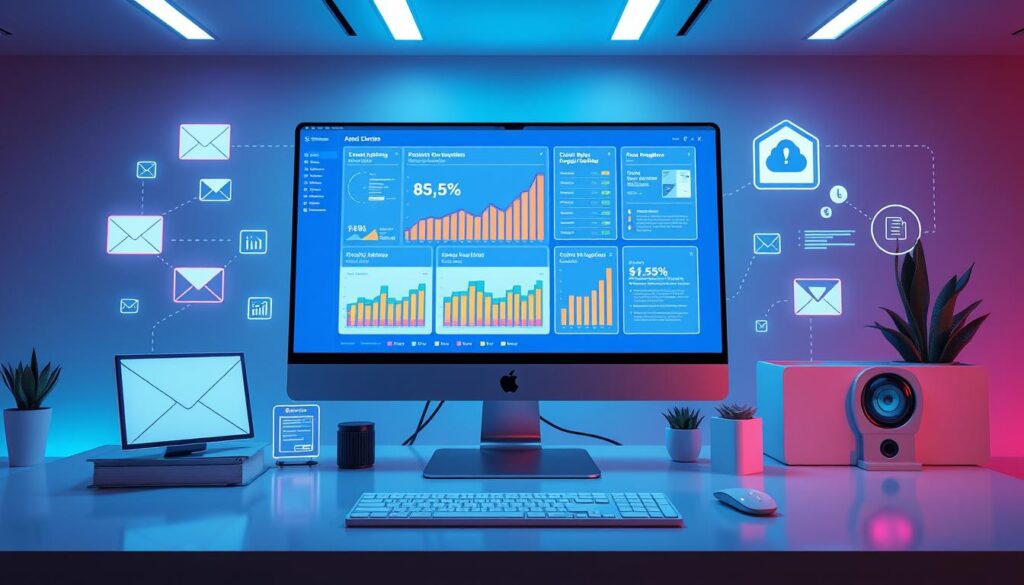Boost your digital marketing by using email marketing automation. Statistics show 91% of consumers read reviews before buying. This highlights the need to create strong customer relationships. Automated email marketing makes it easier to connect. It sends content that fits each subscriber, helping them become loyal customers.
Email campaign automation does more than keep customers interested. It also brings real benefits to businesses. Thanks to automation, email open rates jump by 70% and sales conversions by 120%. Plus, it frees up to 50% of sales teams’ time from manual work. This lets them build better relationships and grow the business.
At the core of these approaches are advanced email marketing tools. They not only make work easier but also boost customer engagement by 80%. With 75% of businesses seeing a higher ROI and a 60% boost in keeping customers thanks to personalized emails, the benefits are clear. Personalizing emails makes customers feel closer to your brand and stay loyal.
Key Takeaways
- Knowing what customers like and do is crucial for email marketing automation success.
- Using automated email marketing greatly improves open rates and sales.
- Email campaign automation significantly saves time and boosts customer interest.
- Spending on email marketing tools pays off with higher profits and customer loyalty.
- Tailoring emails to each person is key in making them love your brand for the long haul.
Understanding the Importance of Email Automation
Email automation is key in today’s marketing world. It boosts both the effectiveness and accuracy of email campaigns. By adopting email automation, businesses can better engage with their audience and simplify their marketing workflows. This move helps send personalized messages to many people, overcome manual campaign limits, and fully use email’s power.
Benefits of Automating Your Campaigns
Automating your email marketing can change how you communicate with your audience, making messages more relevant and engaging. It lets you send personalized emails based on what users do and like. This leads to better email opening and clicking rates. Campaign Monitor shows that automated emails bring in 320% more revenue than non-automated ones, highlighting their financial benefits.
Also, automated welcome emails get four times more reads and five times more clicks than regular emails. They meet the expectations of 74% of people who look forward to receiving a welcome message. Moreover, these emails can make up to 320% more money per email than other promotional emails, proving their effectiveness in boosting earnings.
Common Challenges in Manual Email Marketing
Handling email campaigns by hand comes with big challenges, like not being able to scale and send timely, customized messages. About 70% of online shoppers leave their carts, and without automation, getting them back is tough. Adding personalized recommendations could lift sales per email by 150%, but manual methods are often too slow to analyze the needed data quickly.
Furthermore, as VentureBeat reports, automated emails can lead to 180% higher conversion rates than mass emails. This shows the advantage of sending individualized messages that truly speak to customers’ needs, something hard to achieve without automation tools.
How Automation Can Enhance Customer Engagement
Using automation in email marketing lets businesses send timely, relevant, and personalized messages. Forbes found that 71% of shoppers dislike impersonal shopping experiences. Automation fixes this by making sure messages are custom-tailored, improving customer satisfaction and engagement.
Choosing automation doesn’t just make customers happier; it also helps businesses grow. Oberlo notes that email marketing brings an impressive return of $42 for every $1 spent. This shows the huge profit potential of email marketing and the role of automation in tapping into it.
Selecting the Right Email Automation Tools
Choosing the right email automation software is crucial for your marketing. It requires comparing features like integration capabilities, analytics, and customer journey orchestration.
Key Features to Look For
Top email marketing automation suites come with key features that enhance your marketing. These features are:
- Strong integration with CRM systems and analytics tools.
- Real-time tracking and analytics for measuring email success and engagement.
- Advanced reports that help shape future marketing campaigns.
- Automation tools for crafting personalized and well-timed email sequences.
- Tools for ensuring your emails reach the inbox and are engaged with.
Top Email Automation Platforms
The market has several email automation platforms known for their strength and efficiency:
- Salesforce Marketing Cloud: It connects well with sales and service clouds, providing a complete customer view.
- Woodpecker: Great for cold emailing, perfect for businesses expanding their reach.
- Smartlead: Has plans for both individual marketers and growing businesses.
- Reply.io: Offers solutions that grow with your business, focusing on multichannel engagement.
Comparing Pricing and Functionality
Matching email automation tools with your needs and budget is key. Here’s a comparison of popular platforms:
| Platform | Plan | Price/Month (billed annually) | Features |
|---|---|---|---|
| Salesforce Marketing Cloud | Custom | Custom Pricing | Complete integration, Advanced analytics |
| Woodpecker | Cold Email Plan | $29 | Emailing 500 contacts monthly |
| Smartlead | Popular Plan | $79 | Increased leads and emails, Custom CRM |
| Reply.io | Ultimate Plan | $139 per user | Full multichannel engagement, highest support level |
This information helps businesses pick an email automation platform. They can weigh the costs against the must-have features.

Designing Automated Email Workflows
Effective automated email workflows are key to using email campaign automation fully. They enable precise targeting and timely engagement. This keeps customers involved at every journey stage.
Mapping Out Your Customer Journey
It’s crucial to know the journey your customers take from first awareness to buying. Mapping out key moments in this journey helps. Businesses can use automated emails to send the right info and offers at important times. This makes sure communications are effective and engage well.
Best Practices for Workflow Design
Successful email campaign automation is built on good workflow design. This includes keeping your email list clean and updated for better delivery rates. Using personalization tokens and AI for content can increase opens and conversions.

| Metric | Value |
|---|---|
| Percentage of users creating custom tokens | Marketing Hub Enterprise subscription holders |
| Email tool vs. Workflows tool creation ratio | Automated emails predominantly created in workflows tool |
| Exclusion of low engagement contacts | Common among users setting up automated campaigns |
| Default send frequency cap | Set by HubSpot to prevent inbox overload |
| Impact of personalization tokens | Significantly higher email usability in targeted workflows |
| Changes in graymail suppression | Reviewed post-automation implementation |
| Requirement for authenticated emails | Necessary when not using a connected sending domain |
| Effectiveness comparison | Higher for emails sent from connected sending domains |
Crafting Compelling Email Content
The key to great email marketing is creating content that grabs and keeps attention. It’s important to know how automated emails work. Also, how to talk to your audience well. Adding changing content and testing different things can boost interest and actions taken.
Writing Engaging Subject Lines
The subject line is crucial in email marketing. About 68% of Americans say the sender’s name decides if they’ll open an email. Both the sender’s name and subject line are important. Keep subject lines short, under 50 characters, to be seen on all devices. Words that encourage action, like “Discover,” “Learn,” or “Explore Your Options, {{firstname|fallback=’Valued Customer’}},” help a lot.
Personalization Techniques That Work
Personalizing emails is key to engaging customers. Email tools offer advanced ways to customize messages using real-time data. This could mean changing content based on what the user did before. Using tags like “firstname,fallback=customer” increases how many open the emails. Also, dividing email lists by demographics or past actions helps in sending more focused emails.
A/B Testing for Optimal Results
Testing different versions of emails, A/B testing, is very important. It lets marketers send two versions to see which one works better. This leads to decisions based on data. Testing can be done on subject lines, call-to-action buttons, or layouts. For example, tweaking a word in a call-to-action can boost conversions by 14.79%.
Also, keeping content updated and optimized is crucial for success over time. Improving email marketing automation means frequent reviews and changes, informed by data like open and click-through rates.
For more on creating successful email campaigns, check out TDG Marketing online. There, you’ll find tips on making emails that really work.
Measuring Success and Optimizing Campaigns
In the fast-paced world of email marketing, measuring your campaign’s impact is key. By looking at important metrics, companies can make their email efforts more effective. This involves using their email marketing automation suite to its fullest. Knowing these numbers helps you see what’s working and what needs change. It also helps plan for the future.
Key Metrics to Track in Email Marketing
Knowing how your campaigns are doing is about watching specific numbers. Open rates show how many people are opening your emails. Click-through rates then tell you how many are interacting with what they find inside. Conversion rates go one step further. They show how many people did what you wanted them to do after opening the email. These numbers together give you a full picture of how your emails are performing.
Analyzing Campaign Performance
Looking deeper into campaign data is essential. Unsubscribe rates and spam complaints are warning signs. They suggest it might be time to look at your email frequency or content. Watching how new subscribers sign up and stay engaged is also key. Also, using segmentation and personalization can boost this engagement. Knowing this is critical for good email campaign management.
Continuous Improvement Strategies
Always improving your email strategy is vital for long-term success. This is where A/B testing comes into play. It lets you test ideas with real users to improve your emails. Staying flexible and responding to what your subscribers say keeps your campaigns fresh. Making small, data-driven changes can lead to big results. This approach keeps your email efforts growing and improving over time.
FAQ
What are the benefits of automating email marketing campaigns?
Automating your email campaigns can save a lot of time and effort. It makes it easier to send personal messages to many people at once. This leads to more people engaging with your emails and potentially more sales.
What are common challenges in manual email marketing?
When you do email marketing by hand, it’s hard to reach a lot of people. It’s tough to send out messages at the perfect time. Mistakes can happen easily, and you might miss chances to connect with customers right when they’re interested.
How can email automation enhance customer engagement?
Email automation helps by sending the right message at the perfect time, based on what we know about someone. This way, messages are more likely to hit home and encourage a response.
What are the key features to look for in email automation software?
Look for software that plays well with other tools, gives you live updates, and has great reporting. It should also let you guide your customers on a journey without hitting any bumps.
Which are the top email automation platforms currently available?
The best platforms depend on your specific needs. Big names include Mailchimp, ActiveCampaign, and HubSpot. They offer a mix of features, scale, and ways to make it your own.
How should businesses compare pricing and functionality in email automation tools?
Businesses should think about their goals, budget, and how personalized they want their communications to be. They should pick a platform that provides the needed features without breaking the bank.
Why is mapping out your customer journey important in automated email workflows?
Understanding your customer journey helps you see opportunities for automation. This knowledge lets you create more personalized and effective messages through the entire customer experience.
What are the best practices for designing automated email workflows?
To design great workflows, first understand your customers’ actions. This helps in crafting journeys that lead to the results you want. Keeping your email list clean is also key for ensuring your messages actually get seen.
What makes an email subject line engaging?
An engaging subject line is short and to the point. It sparks curiosity and feels personal. It should hint at what’s inside the email but still grab your attention.
Which personalization techniques are effective in automated email marketing?
Effective techniques involve using current data to cater to what each person likes. You should also tailor your messaging and content based on someone’s past actions and preferences.
How does A/B testing contribute to optimal email content results?
A/B testing lets you see what works best in your email campaigns. By testing different elements, you can use facts to make your emails more effective.
What are the key metrics to track in email marketing?
Important metrics include how many people open your emails, click on links, make a purchase, or decide to stop subscribing. Watching these helps you understand if your emails are successful.
How should a company analyze its email campaign performance?
A company should look at important metrics and notice any trends or unusual patterns. It’s also vital to consider how different aspects of your emails affect your overall results.
What are some continuous improvement strategies for email marketing campaigns?
Keep refining your strategy based on testing results and feedback from subscribers. Update your email lists often and adjust your campaign’s content and timing to match what your users like.



